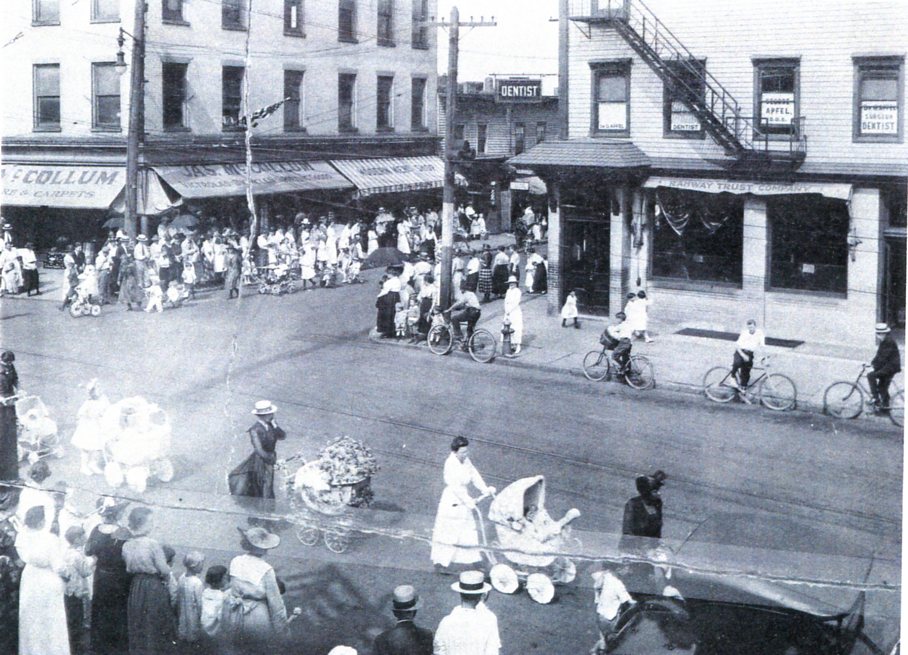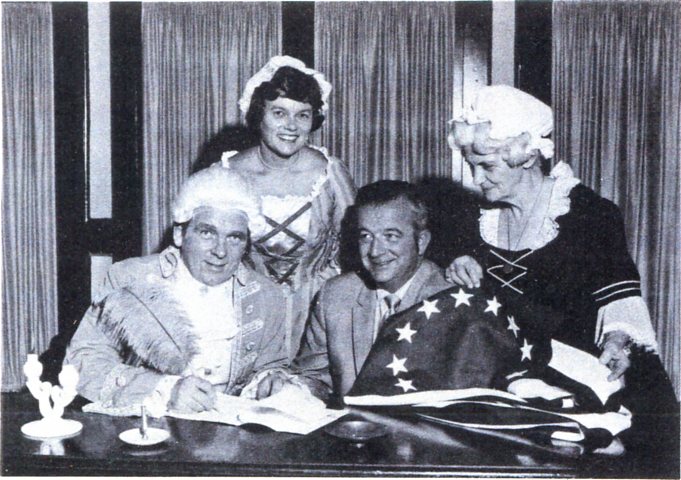
(above) A Baby Parade turns from Cherry Street onto Irving Street in this 1920 event sponsored by the Visiting Nurse Committee of the Civic Club.
Front Page News from 100, 75, and 50 Years Ago
Submitted by Al Shipley, City Historian and Rahway Library Research Consultant
For the past four years, the January history article has gone back to the stories that were covered in the issues of the local paper from 100, 75, and 50 years ago. Let’s again turn back the pages of time to discover some of the issues facing the citizens of our town.
1920
World War I was over and peacetime brought with it a renewed feeling of brotherhood and unity. It was a time when people wanted to be with others and to do things to benefit others. Membership in an assortment of fraternal and social clubs and in churches boomed and became places to fill the social needs of the community. Clubs included the Elks, the Redmen, the Ilderan Club, the Yacht Club, the YMCA, the American Legion, the Moose, the Foresters, the Eagles, the Odd Fellows, the Athenian Club, and the Hibernians to name a few. Churches and temples were open most evenings for fellowship. The groups became venues for all sorts of social activities and would host parties, shows, bazaars, dances, fairs, banquets, block parties, musicals, and baby parades.
The Rahway Federation of Churches was an influential group consisting of local ministers who served as the moral compass in regards to the social issues of the time. They advocated the strict licensing of pool halls, the enforcement of the laws pertaining to prohibition, the preservation of the Sabbath, and riled against the growing age of profanity in print and in public.
In July, city officials urged action to create a Union County Park System that would include the Poor Farm acreage off St. Georges Avenue. In January, 1922, the first piece of the Rahway River Parkway was established.
The 19th Amendment, ratified by the United States Congress on August 18, 1920, gave women the right to vote. The women of Rahway formed the League of Women Voters on September 27 and by that time had already registered over 8,000 women.
1945
The war was still raging in Japan and the citizens of Rahway were still doing their part in helping the cause by rationing coal, waste paper, rags, cans, and scrap paper.
President Franklin Roosevelt died on April 12. Cities all across the country paid tribute to his passing. Rahway paid homage to the fallen leader with a memorial service held in the Rahway High School auditorium which was attended by over 1,000 persons.
At 6:00 on the evening of August 16, announcements came over the radio that Japan had finally surrendered, putting an end to World War II. Once the news spread, it seemed that everyone headed to the center of town. Within an hour, a spontaneous celebration had broken out on Irving Street completely shutting it down from Central Avenue to Milton Avenue. Thousands of cheering residents, armed with any item that would make noise, and a parade of cars with horns blaring and radios blasting jammed the entire length of the street. The sounds of church bells, factory sirens and the whistles of passing trains augmented the cacophony of the celebration that lasted into the night. In their next issue following the celebration, the local paper ran the banner headline “Rahway Vies with Times Square and Fleet Street Celebrating.”
City officials met with veteran groups to begin formulating programs to help returning GIs readjust to civilian life and studies were also being made to address housing needs.
Early in the year, on January 18, the “Rahway Boosters, advocates of high school sports, changed their name to the “Sideliners.” As one member explained, “Those who sit on the sidelines are those who would improve sports and that is exactly our aim in this organization.”
1970
The year started with one of the largest fires in the history of the city. On the morning of Sunday, January 4, the historic Cross Keys Hotel (corner of Campbell Street and Cherry Street) caught fire and continued to burn out of control despite the efforts of Rahway firefighters and squads from four neighboring communities. Freezing temperatures, icy conditions, and thick smoke, greatly hampered the 100 firemen who battled the blaze.
City officials continued to press railroad officials demanding they clean up the trestle properties throughout the city, including the retaining walls and embankments. They also pressed for the construction of a new station. A modern station would be built in 1975 that would serve the city until 1999 when it was razed and replaced by the attractive station that stands to this day.
Public buildings including a new Public Works headquarters, located at the corner of E. Hazelwood Avenue and Hart Street, and the JFK Center on E. Hazelwood were built in 1970. Plans were underway for the construction of Rahway Plaza Apartments, two, twelve story buildings on E. Main Street. Plans were also being discussed for a new fire headquarters/police station complex and a new site for city hall. A new fire headquarters was built in 1975 and the city hall/police station complex opened in 1982.
The Rahway Historical Society purchased the building on the corner of St. Georges Avenue and Westfield Avenue, known to all as “the Girl Scout House,” from the Searles estate for $75,000. The transfer took place during a masquerade ball held at the Ilderan Club on the evening of October 31.

(above) Officers of the Rahway Historical Society sign the paperwork for the purchase of the Girl Scout House (Merchants and Drovers Tavern Museum.)
